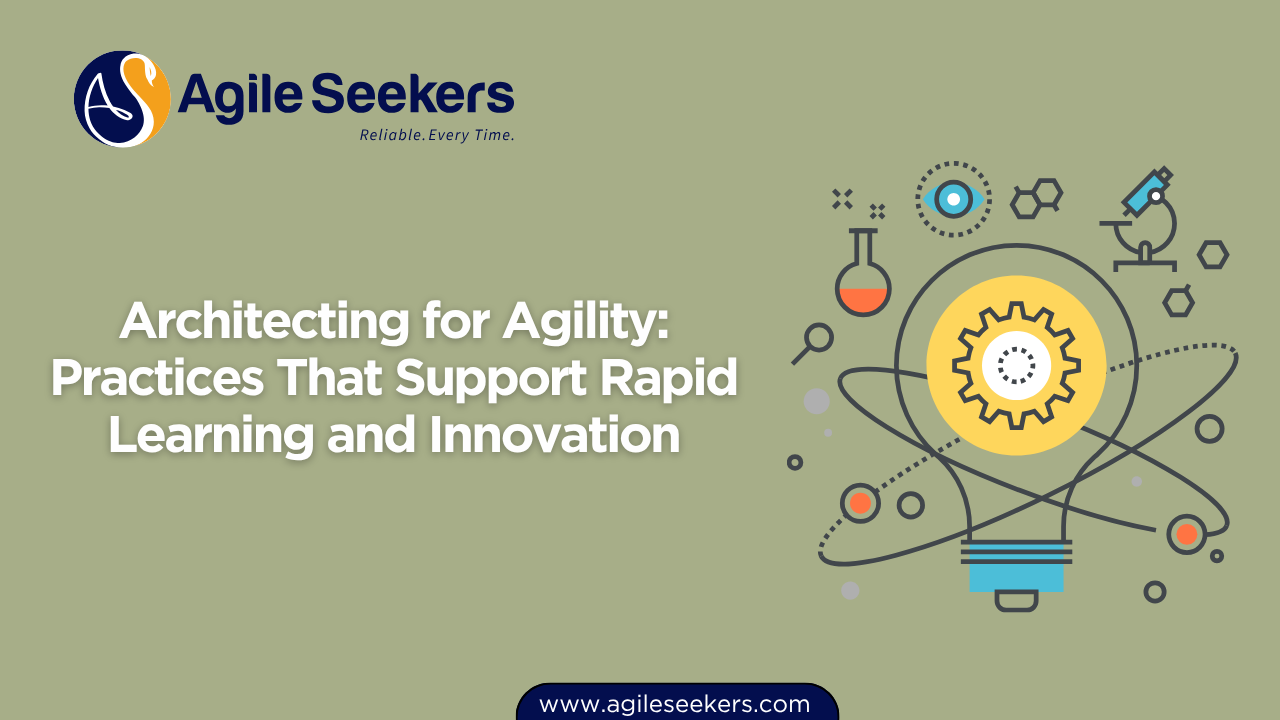Architecting for Agility: Practices That Support Rapid Learning and Innovation

Agile architecture is not about rigid control or heavy documentation. It’s about creating a flexible, testable, and scalable foundation that enables rapid delivery of customer value. In a SAFe enterprise, architects must support fast feedback cycles, continuous exploration, and decentralized decision-making — all while maintaining coherence across the system.
To achieve this, SAFe emphasizes a set of core architectural practices that help organizations balance agility with alignment. This post focuses on three key enablers: model-based systems engineering (MBSE), architectural testability, and capacity buffers — each playing a vital role in unlocking rapid learning and innovation.
Why Architecture Matters in Agile
Many teams mistakenly view architecture as something that slows down delivery. That only happens when architecture becomes overly prescriptive. In contrast, Agile architecture provides guardrails, not barriers — enabling teams to explore options safely, evolve design incrementally, and pivot when needed.
That’s why modern SAFe Architects act less like gatekeepers and more like enablers. They focus on building architectural runway, promoting testable solutions, and guiding decentralized decision-making.
For professionals looking to deepen their understanding of this role, the Leading SAFe Agilist Certification Training offers critical insight into how architecture enables enterprise agility.
1. Model-Based Systems Engineering (MBSE): Reducing Complexity Through Abstraction
MBSE replaces traditional document-heavy design with dynamic, interconnected system models. These models allow teams to simulate, analyze, and validate the system behavior early — long before a line of production code is written.
How MBSE Supports Rapid Learning:
-
Early feedback: Engineers can evaluate design trade-offs through simulations, reducing rework later.
-
Shared understanding: System behavior is visualized, which enhances communication across teams.
-
Traceability: Changes are easier to assess because dependencies are explicitly modeled.
In large enterprises, where multiple Agile Release Trains (ARTs) collaborate across domains, MBSE supports alignment while allowing teams the autonomy to innovate locally. It also enables Solution Architects to visualize end-to-end value flows, which ties directly into the responsibilities explored in SAFe Product Owner/Product Manager POPM Certification.
✅ External reference: The INCOSE MBSE initiative highlights how MBSE helps improve decision quality and reduce development risk across complex systems.
2. Architectural Testability: Designing for Fast Feedback
Testability isn’t just the responsibility of developers or testers — it starts at the architecture level. If your architecture is not testable, then it’s not agile.
Key Practices That Improve Testability:
-
Loose coupling and high cohesion: Isolated components are easier to test independently.
-
Service virtualization: Teams can simulate external dependencies to run tests early.
-
Observability: Logs, metrics, and tracing should be built-in, not bolted-on.
Testability supports continuous integration and continuous delivery, which are essential in a DevOps pipeline. Without testable architecture, feedback cycles stretch, and learning slows. This is especially relevant for Scrum Masters enabling high-performing Agile teams, a role deepened in the SAFe Scrum Master Certification.
For large programs, architects should drive architectural enablers into the backlog to improve testability — a practice often overlooked but essential for sustained agility.
3. Capacity Buffers: Creating Space for Innovation
Innovation doesn’t happen when every sprint is packed with features. Teams need the capacity to learn, explore, and improve. That’s where architectural buffers and innovation spikes come into play.
Ways to Build in Buffers Without Losing Velocity:
-
Enablers in PI Planning: Allocate explicit capacity for architectural work.
-
Innovation and Planning (IP) Iteration: Use the final iteration of the Program Increment for learning and experimentation.
-
Slack for refactoring: Allow room for technical debt reduction and emergent design.
Capacity buffers are not wasted effort — they are investments in resilience. They give teams the breathing room to think strategically and validate bold ideas.
The SAFe Advanced Scrum Master Certification Training helps leaders guide teams through these trade-offs and improve flow without compromising predictability.
🔍 External Insight: Google’s “20% time” policy is a well-known example of how protected innovation time can drive breakthrough ideas like Gmail and AdSense.
Connecting the Dots: Architecture as a System Enabler
When architecture is treated as an enabler rather than a constraint, agility follows. Here’s how the pieces work together:
-
MBSE reduces complexity and aligns vision.
-
Testable architecture shortens feedback loops and lowers risk.
-
Buffers create time for innovation and reflection.
These practices are especially important when operating at scale. Release Train Engineers (RTEs) rely on architectural stability to ensure that multiple teams can deliver in sync. The SAFe Release Train Engineer Certification Training dives deep into managing these system-level dynamics.
Final Thoughts: Architecting for Learning, Not Just Control
The most successful enterprises are not the ones that build the most features — they are the ones that learn the fastest. Agile architecture is what makes this possible. It enables teams to move with speed and safety, empowering them to experiment, adapt, and continuously deliver value.
By embedding practices like MBSE, testability, and capacity buffers into the system, architects help create a runway for innovation rather than a checklist of rules.
If you're involved in SAFe implementation and want to architect for real agility — not just structure — then it's time to go beyond frameworks and focus on mindset, flow, and learning.
To lead such transformation efforts at scale, consider exploring the Leading SAFe Agilist Certification Training for a deeper foundation in Lean-Agile leadership.
Also read - How Architects Contribute to Lean Portfolio Management and Strategy Execution
Also see - Why Every Agile Team Needs Architectural Thinking—Not Just Architects




















